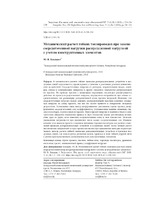| dc.contributor.author | Бладыко, Ю. В. | ru |
| dc.coverage.spatial | Минск | ru |
| dc.date.accessioned | 2018-05-29T05:35:09Z | |
| dc.date.available | 2018-05-29T05:35:09Z | |
| dc.date.issued | 2018 | |
| dc.identifier.citation | Бладыко, Ю. В. Механический расчет гибких токопроводов при замене сосредоточенной нагрузки распределенной нагрузкой с учетом конструктивных элементов = Mechanical Calculation of Flexible Wires when a Concentrated Load is Being Replaced with a Distributed One Taking into Account the Structural Elements / Ю. В. Бладыко // Энергетика. Известия высших учебных заведений и энергетических объединений СНГ. - 2018. - № 3. - С. 220-234. | ru |
| dc.identifier.uri | https://rep.bntu.by/handle/data/41607 | |
| dc.description.abstract | В механическом расчете гибких проводов распределительных устройств и воздушных линий определяются стрелы провеса и тяжения в различных режимах климатических воздействий. Сосредоточенные нагрузки от распорок, заградительных шаров, шлейфов, отпаек к электрическим аппаратам и других элементов заменяются распределенной по пролету. На примере пролета с натяжными гирляндами изоляторов рассматривается действие на провод сосредоточенных нагрузок, определяется погрешность при замене сосредоточенных сил равномерно распределенной вдоль пролета нагрузкой. Показано, что сосредоточенные нагрузки нельзя заменять распределенными простым делением суммарных нагрузок на длину пролета, так как это может привести к совершенно неверным результатам. Установлена связь между коэффициентом увеличения стрелы провеса, коэффициентом сосредоточенных сил, коэффициентом, учитывающим наличие натяжных гирлянд изоляторов, и углом наклона пролета. При ветровой нагрузке и наличии отпаек к электрическим аппаратам отклонения провода в двух плоскостях можно рассчитывать независимо друг от друга, если известны сосредоточенные силы в этих плоскостях. Показано уменьшение погрешности при увеличении числа малых сосредоточенных сил. Оценено влияние угла наклона пролета и наличия натяжных гирлянд изоляторов для расчета отклонений проводов распределительных устройств и воздушных линий. Более точный расчет механических напряжений и стрел провеса возможен при применении векторно-параметрического метода расчета гибкой ошиновки распределительных устройств и проводов воздушных линий, где используется расчетная модель проводов в виде гибкой упругой нити с учетом пространственного расположения всех конструктивных элементов. | ru |
| dc.language.iso | ru | ru |
| dc.publisher | БНТУ | ru |
| dc.subject | Sag | en |
| dc.subject | Tension | en |
| dc.subject | Flexible thread | en |
| dc.subject | Insulator strings | en |
| dc.subject | Equation of state | en |
| dc.subject | Span | en |
| dc.subject | Equivalent wire | en |
| dc.subject | Load factor | en |
| dc.subject | Стрела провеса | ru |
| dc.subject | Тяжение | ru |
| dc.subject | Гибкая нить | ru |
| dc.subject | Гирлянды изоляторов | ru |
| dc.subject | Уравнение состояния | ru |
| dc.subject | Пролет | ru |
| dc.subject | Эквивалентный провод | ru |
| dc.subject | Коэффициент нагрузки | ru |
| dc.title | Механический расчет гибких токопроводов при замене сосредоточенной нагрузки распределенной нагрузкой с учетом конструктивных элементов | ru |
| dc.title.alternative | Mechanical Calculation of Flexible Wires when a Concentrated Load is Being Replaced with a Distributed One Taking into Account the Structural Elements | en |
| dc.type | Article | ru |
| dc.identifier.doi | 10.21122/1029-7448-2018-61-3-220-234 | |
| local.description.annotation | In the mechanical calculation of the flexible wires of substations and overhead lines, sags and tension are determined in various climatic conditions. Concentrated loads from spacers, barrier balls, stubs, taps to electrical apparatus and other elements are replaced with a load distributed over the span. On the example of a span with tension insulator springs, the action of concentrated loads on the wire is considered, the error is determined when the concentrated forces are replaced with a load one that is uniformly distributed along the span. It is shown that concentrated loads cannot be replaced with distributed ones by simple division of total loads by the span length, since this might result in completely incorrect findings. A relationship is established between the coefficient of the increase of the sag, the coefficient of concentrated forces, the coefficient that takes into account the presence of tension insulator springs, and the angle of inclination of the span. With wind load and the presence of taps to electrical apparatus, the deviations of the wire in two planes may be calculated independently of each other if the forces concentrated in these planes are known. A decrease in the error is shown with an increase in the number of small concentrated forces. The influence of the angle of inclination of the span and the presence of tension insulator springs on calculating the deviations of the wires of substations and overhead lines is assessed. A more accurate calculation of mechanical tensions and sags is possible with the use of a vector-parametric method for calculating the flexible bus of switchgears and wires of overhead lines, where the design model of wires in the form of a flexible elastic thread is used, taking into account the spatial disposition of all structural elements. | en |

